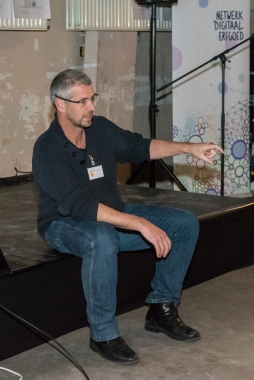
Enno Meijers works as an information manager at the National Library of the Netherlands and an invited industry speaker at Semantics. The biggest challenge of the National Library is the development of the digital heritage infrastructure avoiding aggregating and postprocessing of the data and instead realize a true distributed network of digital heritage information.
Can you tell something about your work/research focus?
The National Library is one of the partners in the Dutch Digital Heritage Network program. This is a national program aimed at increasing the social value of the collections maintained by the Libraries, Archives and Museums in the Netherlands. My work is focused at the development of a new, cross domain discovery infrastructure for the heritage collections based on Linked Data principles. In this new infrastructure our goal is the improve the usability of the collection data at the source. In order to do so we urge the maintainers of the collections to align their data with formal Linked Data resources, like thesauri (people, place, periods, concepts) and to publish data as Linked Open Data. One of the tools we are using for organizing these Linked Data resources is PoolParty from Semantic Web Company. Our biggest challenge is the development of the digital heritage infrastructure avoiding aggregating and postprocessing of the data and instead realize a true distributed network of digital heritage information.
Prior to this job I have been one of the lead architects of the National Library Catalogue platform build as one of the services for digital infrastructure for the Public Libraries (bibliotheek.nl). I was involved in founding the Dutch DBpedia chapter (http://nl.dbpedia.org/) and currently I am a member of the DBpedia Association Board.
Which trends and challenges you see for linked data/semantic web?
In my opinion we are slowly moving away from the strong focus on publishing Linked Data we had before. The potential of Linked Data as a data integration technology is still attracting more and more attention. Another interesting trend is the growing urge to move away from the ‘repository centric’ approach to the ‘web centric’ approach. Recent developments like Linked Data Fragments, Resource Sync, Linked Data Notification will enable Linked Data producers and consumers to interact with each other in a more easy way without the need for large intermediate layers for harvesting and processing data. My special interest is the idea of combining this trend with the emerging technologies for the distributed web like IPFS and blockchain. I am curious what added value could result from working with Linked Data in a distributed web environment.
What are your expectations about Semantics 2017 in Amsterdam, especially about the industry track?
It is very interesting to see tools how Linked Data tools are maturing through the years. Where performance and functionality of tools were challenging in the early days, nowadays there is quite a broad range to choose from. It is interesting to follow the developments in this market. Another aspect is the growing adoption by of Linked Data technologies by organizations in order to improve the efficiency of process. From my background as an information professional is very interesting to see the way companies like Wolters Kluwer and Springer Nature are investing in Linked Data technology to improve their core production processes. I am excited to read that Semantics this year introduces a Data Science track, which will focus on the Data Analytics and Visualization. I think there is large demand for these kind of tools to support people using Linked Data.